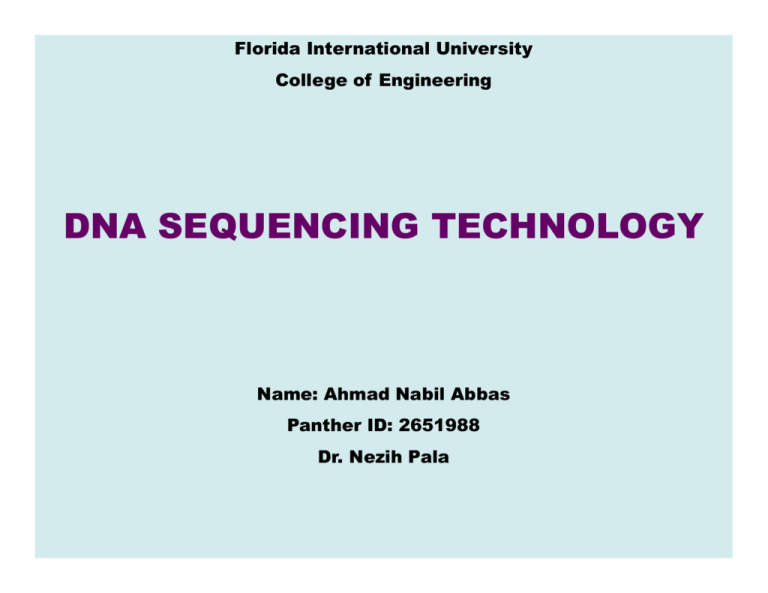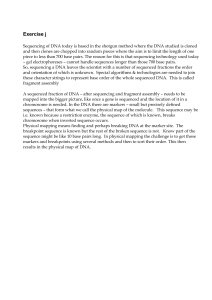dna sequencing technology - Florida International University
advertisement

Florida International University College of Engineering DNA SEQUENCING TECHNOLOGY Name: Ahmad Nabil Abbas Panther ID: 2651988 Dr. Nezih Pala DNA: Is a nucleic acid that contains the genetic instructions used in the development and functioning of all known living organisms and some viruses. -DNA Store information and contains instructions to construct cells -DNA segments that store genetic information are called GENES -There are approximately 25,000 Genes in the Human Genome -In the Cell DNA is arranged into Chromosomes DNA Composition: -Two Polymers of units called NUCLEOTIDES -Double Helix -Backbone Backbone made of Sugar and Phosphate -Attached to the Sugar is one of four kinds of Molecules: adenine (A), cytosine (C), guanine (G) and thymine (T) -Base-pairing rule: A with T , C with G http://www.youtube.com/watch?v=qy8dk5iS1f0 Bases Order in the Genome: -Specific order for different chromosomes -Humans are 99% alike -DNA DNA sequence Determines genetic characters of a human -These characters include any y genetic g disease and/or human property -All creatures have the same structure but different order -Just like a strain of Bits DNA SEQUENCING: methods for determining the order of the nucleotide bases: adenine guanine, adenine, guanine cytosine cytosine, and thymine—in a molecule of DNA. DNA WHY? -The DNA sequences making up any organism comprise the basic blueprint for that organism (The Secret Of Life) Molecular Medicine: -Disease Di Gene G Identification Id tifi ti -Earlier detection of genetic predispositions to disease -Drugs Drugs designed to target specific gene products that cause disease -Pharmacogenomics "custom drugs” -Replacement of defective genes for certain diseases DNA Forensics Human Gene Mutation Agriculture and Breeding: -Disease-, Disease , insect insect-,, and drought drought-resistant resistant crops -Healthier, more productive, disease-resistant farm animals -More nutritious produce -Edible vaccines incorporated into food products DNA Sequencing Requirements: -Fast -Cheap -Accurate The Human Genome Project: An International scientific research project with a primary goal to determine the sequence of chemical base pairs which make up DNA and to identify and map the approximately 20,000– 25,000 genes of the human genome from both a physical and functional standpoint -Started 1990 to 2003 -Parallel Sequencing -sequencing was performed in universities and research centers from the United States, the United Kingdom, Japan, France, Germany, China, Canada, and New Zealand http://www.youtube.com/watch?v=-gVh3z6MwdU The X Prize: The $10 million X PRIZE for Genomics prize purse will be awarded to the first Team that can build a device and use it to sequence 100 human genomes within 10 days or less, with an accuracy of no more than one error in every 100,000 bases sequenced, with sequences accurately covering at least 98% of the genome, genome and at a recurring cost of no more than $10,000 per genome. DNA Sequencing Methods: -1953, James Watson and Francis Crick concluded that DNA contained the "stuff of life“… 1) Maxam-Gilbert Method (1976): -Based on unique q chemical reactions on one or two of the bases. - Steps: *Chemical treatments to break the fragments *Gel Gel Electrophoresis *Autoradiography - Disadvantages: Technical Complexity Complexity, Use of Hazardous Materials 2) Chain-Termination Method (Sanger): -More efficient, Less toxic chemicals than M-G method. Steps: -Four F sett off R Reactions ti are needed d d -In each of them a copy of the DNA needed to be sequenced, an extra supply of A, G, C and T, dideoxynucleotides (ddATP, ddGTP, ddCTP, or ddTTP) which are the chain-terminating nucleotides, a Primer and a DNA Polymerase. -Since Since each copy will be cut in a different position. By time all the possible cuts will happen and various lengths of fragments will be present -The The DNA is then denatured and the contents of each reaction will be placed on a separate lane in the Polyacrylmide gel to separate defferent lengths and UV light will show the tagged base accordingly. http://www.youtube.com/watch?v=aPN8LP4YxPo&feature=related 3) Dye-Terminator Method -Dye-terminator sequencing utilizes labelling of the chain terminator ddNTPs, which permits sequencing in a single reaction, rather than four reactions as in the labelled labelled-primer primer method. -each of the four dideoxynucleotide chain terminators is labelled with fluorescent dyes, y , each of which with different wavelengths of fluorescence and emission htt // http://www.youtube.com/watch?v=dUjMf2ZezIw t b / t h? dUjMf2Z I Advanced Methods: -The X Prize has led to a huge number of contributions -Two methods according to researchers are approaching hi promising i i results lt iin tterms off practicality. - Nanopores And Real-time Real time detection of dNTP incorporation Nanopores DNA sequencing: -A nanopore is a small opening in the order of couple of nanometers diameter separating two chambers with an ability to have single molecules pass through it at a given time -The main idea is to have two ionic solutions in two chambers separated t d by b a nanopore -The underlying principle of nanopore sequencing is that a single-stranded DNA or RNA molecule can be electrophoretically driven through a nano-scale pore in such a way that the molecule traverses the pore in strict linear sequence -Solid state nanopores with probes that serve as atomic scale electrodes whose termini are on opposite sides of the nanopore. p A voltage g bias between these probes p will induce an electronic current stimulated by quantum mechanical tunneling to flow from one side of the nanopore to the other. The current, which will be sensed by an external circuit, will be modulated by the individual nucleotide bases as ssDNA molecules translocate through the nanopore. Nanopores DNA sequencing: Controlling the flow of the ssDNA (DNA translocation): -A certain voltage is applied across the chambers will ill lead l d th the DNA to t fl flow ffrom th the negative ti polarity l it to the positive one with a certain speed according to the voltage g (120 ( mV is currently y being g used). ) -Also application of a certain viscous material at the pore itself can contribute to the speed control of DNA translocation. Current Achievements: -Length and shape Detection -DNA/SWNT Hybrid E Expected t dA Achievements: hi t 1 MBs Current Challenges: -Improve nanopore surfaces to reduce non-specific adsorption, pore clogging, and electrical noise -Fabricate and test a nanopore detector articulated with integrated probes for molecular identification -Develop p new enzymatic y methods to better control and limit the rate of DNA translocation through articulated nanopores -Develop algorithms for signal feature detection and base identification from articulated nanopores Nanopore Technology (Alternative Method): -Developed by NABsys -Parallel pores -Hybrid Hybrid sequencing -Requires amplification (Major Disadvantage) -Applicable Applicable with the current technology htt // http://www.youtube.com/watch?v=HV0aWVrDM2U t b / t h? HV0 WV DM2U Real-Time Detection of dNTP incorporation: -Developed by VisiGene, TX -Showed the most promising results (patents in europe and the US) -Currently Currently achieved 1 MBs Method: -Uses Fluorescently tagged PP1 -The time-dependent fluorescent signals emitted from each complex l are monitored it d and d analyzed l d tto d determine t i DNA sequence information. -Energy gy transfers from donor to acceptor, p , stimulating g emission -Create massively parallel arrays of nanomachines engineered to act as molecular sensors of base identity during dNTP incorporation -Direct analysis - no cloning or amplification Detection System: Video Visualization of the technology: http://www.youtube.com/watch?v=XLjzBTpk5J4&feature=related References: -http://www.nd.edu/~aseriann/maxam.html -http://en.wikipedia.org/wiki/Human_Genome_Project -http://en.wikipedia.org/wiki/DNA -http://genomics.xprize.org/archon-x-prize-for-genomics -http://www.bio.davidson.edu/Courses/Molbio/MolStudents/spring2003/Obenrader/sanger_method_page.htm -http://en.wikipedia.org/wiki/Sequencing_by_hybridization http://en wikipedia org/wiki/Sequencing by hybridization -http://en.wikipedia.org/wiki/DNA_sequencing#cite_ref-22 -http://golgi.harvard.edu/branton/projects-NanoporeSequencing.htm -VisiGene Biotech Inc, Real-Time DNA sequencing -Mary Hughes, Optical Absorption of DNA/Carbon Nanotube Structure, 2007 -Daniel Fologea, DNA Conformation and Base Number Simultaneously determined in a nanopore, 2007. -Fernando Albertorio, Base dependent DNA–carbon nanotube interactions: activation enthalpies and assembly–disassembly control, 2009







